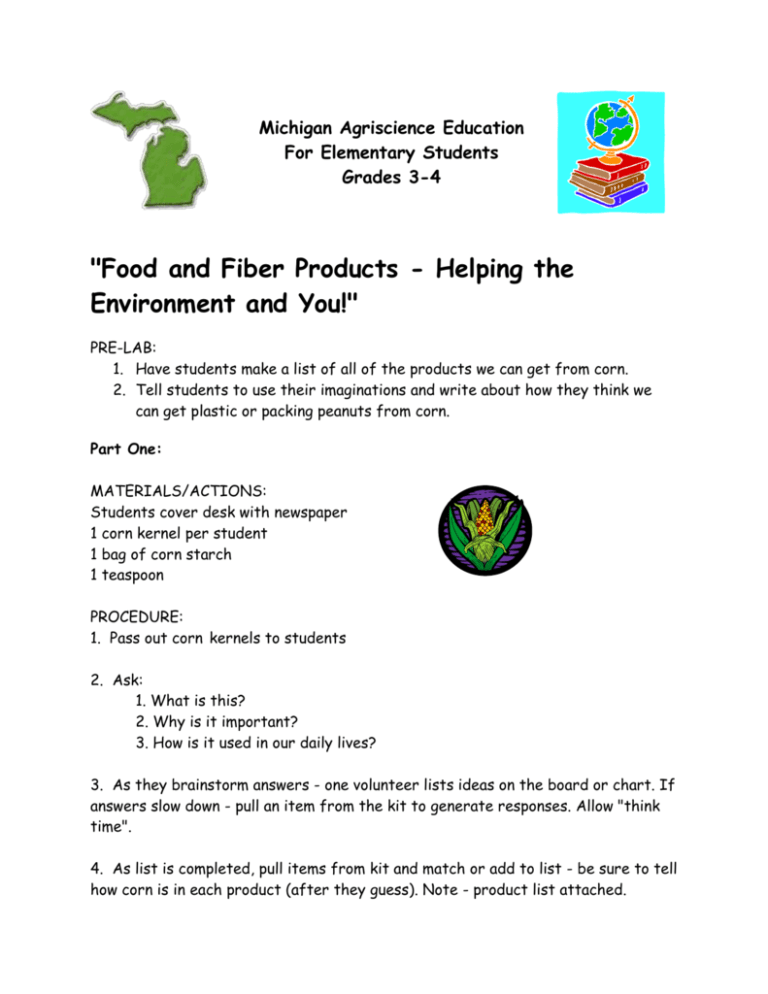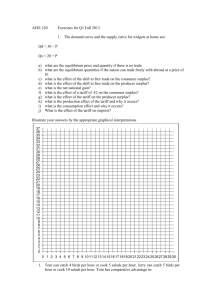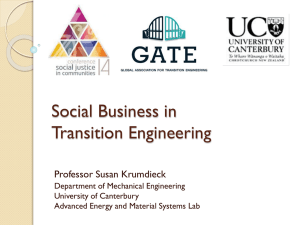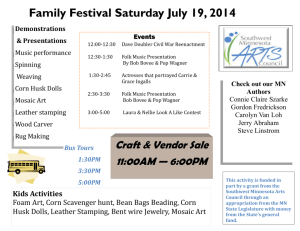"Food and Fiber Products - Helping the Environment and You
advertisement

Michigan Agriscience Education For Elementary Students Grades 3-4 "Food and Fiber Products - Helping the Environment and You!" PRE-LAB: 1. Have students make a list of all of the products we can get from corn. 2. Tell students to use their imaginations and write about how they think we can get plastic or packing peanuts from corn. Part One: MATERIALS/ACTIONS: Students cover desk with newspaper 1 corn kernel per student 1 bag of corn starch 1 teaspoon PROCEDURE: 1. Pass out corn kernels to students 2. Ask: 1. What is this? 2. Why is it important? 3. How is it used in our daily lives? 3. As they brainstorm answers - one volunteer lists ideas on the board or chart. If answers slow down - pull an item from the kit to generate responses. Allow "think time". 4. As list is completed, pull items from kit and match or add to list - be sure to tell how corn is in each product (after they guess). Note - product list attached. 5. Take out cornstarch as last product and pass out a teaspoon to each student. Let them smell, taste and touch cornstarch. Place on towel or newspaper. 6. Ask: 1. What does it feel like? 2. What does it taste like? 3. What does it smell like? 7. Explain: Cornstarch is a versatile corn product because it can be made into different "biodegradable" products. Define "biodegradable" as a natural material that breaks down and returns to the soil. This is recycling. Many years ago when the glaciers receded, they left the clear fresh water that makes up our Great Lakes as well as the many inland lakes that are found throughout Michigan. Because these are an important source of fresh water as well as a tourist attraction - it is very important that we protect the lakes from pollution, Ag-based products will help up do this. Part Two: MATERIALS/ACTIONS: -3 cups per group of students -2 pieces of Styrofoam, corn based packing peanuts and shredded newspaper -3 stir sticks -1 lab sheet - Fill all 3 cups with an equal amount of water. PROCEDURE: 1. Pass out materials for experiment. 2. Divide students into groups of 3. 3. Introduce experiment and review procedure with students - show how glasses of water have an equal amount of water. 4. EXPLAIN: To help you understand that Ag based products are different; we're going to have you do an experiment. In your groups, you will be comparing Styrofoam packing peanuts; corn based packing peanuts and shredded newspaper. All of these products are used to ship items from one place to another. You will be adding these materials to water and observing what happens. This will show what might happen if these materials were accidentally dumped into one of the Great Lakes. 5. Explain while students measure corn pellets, styrofoam, and newspaper: Don't add your materials until the signal. Using your lab sheet, write predictions of what you think will happen to each material. When we say start, then add the materials to your water and stir until we say stop. Do experiment now! Then write one sentence about the experiment and put all your material into the pan we bring around. NOTE: At signal the students add materials to cups and begin stirring. Students make observation after 1 1/2 min. and again at 3 min. Student’s write observations down while volunteer collects waste materials. 6. DISCUSSION: What happened to the Styrofoam? What happened to the cornstarch pellets? What happened to the newspaper? Did stirring help? Which products are Ag-based? (corn and paper) What would happen if we left these products in water for several weeks? (newspaper would dissolve, Styrofoam would not change) 7. Share conclusion sentences with class. State what they saw and why. Talk about other Ag based products. Each group reports back to class with one sentence about what happened. Discuss results and tie it to the discovery of corn's many uses - show industrial products made Industrial products from corn. 8. Talk about other "environmentally friendly" food and fiber products and show examples (see products in kits and commodity list). 9. Wrap up demonstration. Part Three: MATERIALS/ACTIONS: Gallon jug of water – add 1-2 drops of food coloring EXPLAIN: Farmers are careful to be good to the environment. We need to preserve our resources. One of the most important resources is water. Most of our planet is covered with water. Water found in freshwater lakes and rivers is an important drinking source for people and animals. Let me show you how limited our water supply is. Show 1 gallon of water PROCEDURE: 1. Show gallon of water. This gallon of water represents all the water on earth. 2. Pour out 1/4 cup of water into plastic cup. This 1/4 cup of water represents glaciers, ice caps and all the freshwater in the world. 3. Ask a student to volunteer to hold out their hand to demonstrate just how little of the worlds water is available for us to use? Take 2 drops of water from 1/4 cup of water and put in student volunteer's hand. These 2 drops of water represent all the water in freshwater lakes and rivers that are available for people and animals to use. 4. EXPLAIN: Water is an important resource and making biodegradable products from agriculture keeps the water clean. 5. Review the lesson focus: Food and fiber products are friendly to the environment. They can be recycled to create useful products and they keep the land and water clean. For presenter information only: The water is in: The oceans 97.2% Glaciers/ice caps 2.0% Groundwater .62% Freshwater lakes .009% (like the bay) Saltwater lakes .008% Atmosphere .001% (rain/humidity) All rivers 0001% COMPARISON OF PACKING MATERIALS Lab Sheet for Experiment Name(s): ____________________ ____________________ ____________________ Date: ___________________ I. Observation about dry materials Material A – Material B – Material C – II. Prediction of what will happen: A. ____________________________________________________________ B. ____________________________________________________________ C. ____________________________________________________________ III. Observations about materials after stirring (1½ min.): A. ____________________________________________________________ B. ____________________________________________________________ C. ____________________________________________________________ IV. Conclusion (1 sentence please): _____________________________________________________________ _____________________________________________________________ _____________________________________________________________ LIST OF MICHIGAN GROWN COMMODITIES This list is a partial representation of the more than 70 commercial agricultural products grown on Michigan farms. Most crops require well drained soils. Exceptions include blueberries, cranberries, and spearmint. All of which require organic soils and more moisture than other crops. There is a minimal amount of waste in the processing of crops and livestock for consumption. Livestock is a good example of this. Bones and hooves from animals are used in piano keys, adhesive tape, collagen cold cream, bone china, photographic film, and other products. Organs such as intestines are used for sausage casings, instrument strings, and surgical sutures. Unusable parts are composted and become organic matter that can be safely returned to the soil. Fruits/Vegetables snap beans potatoes sweet corn asparagus blueberries carrots cranberries grapes apples tomatoes cherries mushrooms plums peppers apricots pears broccoli strawberries cauliflower onions squash cantaloupes cucumbers celery raspberries/blackberries Field Crops dry beans soybeans corn wheat and grains sugar beets mint hay oats rye barley Nursery/Floriculture gladioli all potted plants (geraniums, poinsettias, other) bedding plants hanging baskets turf trees and shrubs cut flowers (roses, mums, other) dried flowers Trees maple syrup Christmas trees forestry (paper, lumber, other) Poultry/Livestock/Dairy/Fiber hogs sheep/lambs beef cattle dairy cows poultry aquaculture (fish) mink mohair wool milk and dairy products (butter, ice cream, etc.) eggs chicken/turkey veal calves llama ostrich List of Contacts for Corn-based Products: Golf Tees: Gary Larrivee Terra Form P.O. Box 292 Dalton, MA 01227 (413) 684-9771 Packing Peanuts: For Additional Sources contact: Michigan Corn Growers Association 504 S. Creyts Rd., Suite A Lansing, MI 48917-8230 (517) 323-6600 Fax: (517) 332-6601 American Excelsior 70 Cleveland Rd. Norwalk, OH 44857 (800) 968-4375 ext. 226 Fax: (419) 663-7169 Plastic Tableware: American Precision Plastics 11060 Irma Drive Northglenn, CO 80233-3611 (303) 457-2400 Windshield Fluid: Hydrosorb: Tom Meyer Acquainis Technologies 12231 Manchester Road St. Louis, MO 63131 (314) 822-4240 Steve Ayers (not corn-based) Central Illinois Manufacturing Co. 201 N. Champaign Street Bement, IL 61813 (217) 678-2231 Biodegradable Pens: Roatan International 20 West 38th Street New York, NY 10018 (212) 768-7538 Biodegradable Bags: Michigan Biotechnology Institute (MBI) 3900 Collins Road Lansing, MI 48910 (517) 336-4628 or (517) 336-4673 “Food and Fiber Products are Environmentally Friendly” Packing List Based on 35 students per class Each kit is designed for conducting 2 presentations Kit materials needed: - 70 paper towel sheets (student clean-up) - 70 small clear plastic cups (3 per group or 1 per child) – collect and reuse - 45 pieces Styrofoam peanuts in baggies - 45 pieces of corn peanuts in baggies - 45 pieces of newspape in baggies - 35 stir sticks (rubber band and reuse) - 1 milk jug - 1 milk jug – cut down to collect waste water - 1 plastic teaspoon - 70 sheets newspaper to cover desks - 1 trash bag for clean-up - 70 lab sheets - 1 bottle blue food coloring - corn kernels (3 per student) - assorted items made from corn (golf tees, pop, candy corn, cornmeal, etc.) - cornstarch - samples for industrial or alternative products from commodities – golf tees, soystone, wool, etc. * Original can be found at Michigan Ag in the Classroom, www.miagclassroom.org







